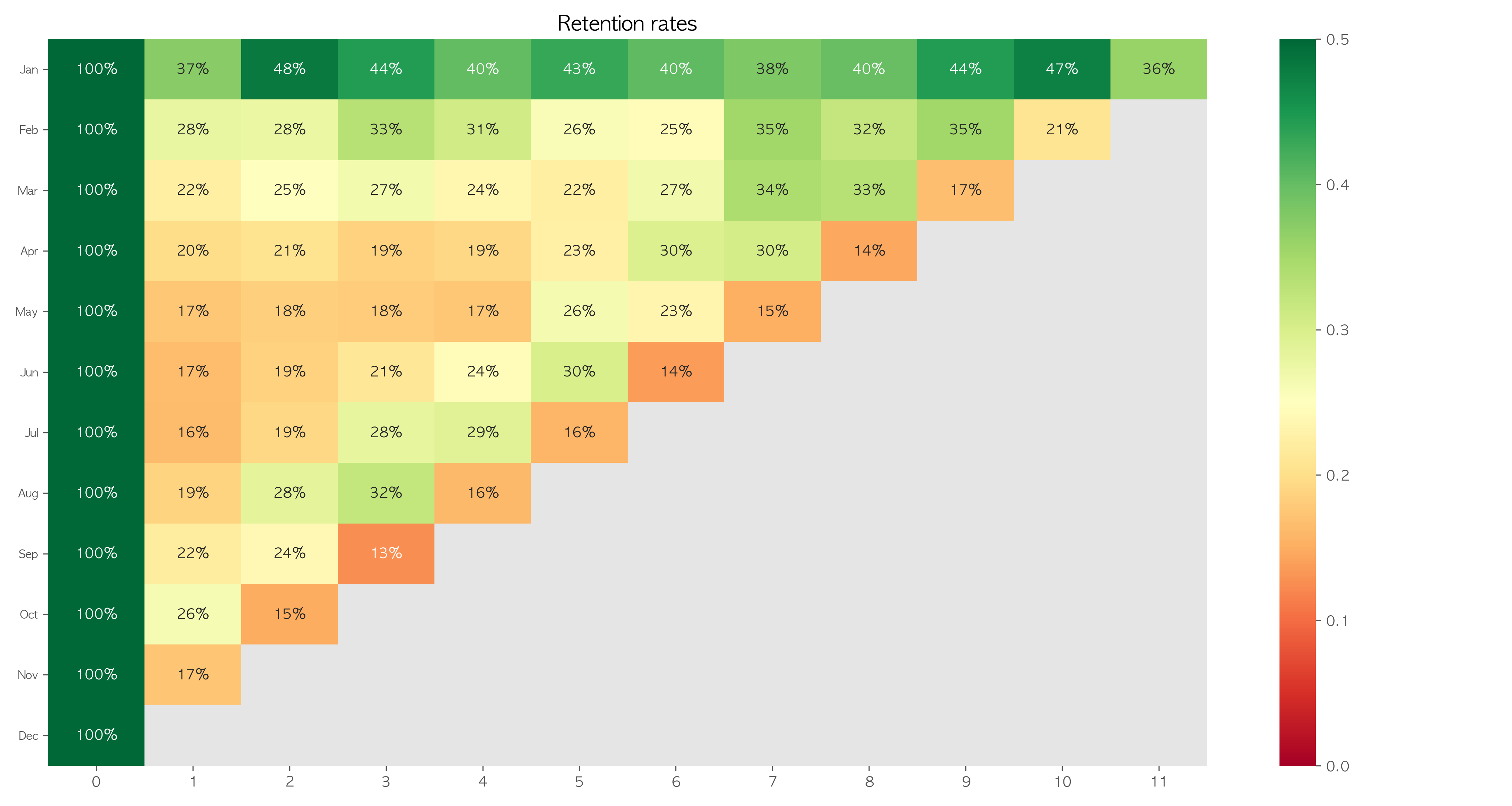선물 상품을 주로 판매하고 있는 영국의 도매상 2년간의 실제 전자상거래 데이터이다.
2009년 12월 1일부터 2011년 12월 9일까지의 거래 내역을 포함하고 있다.
RFM Analysis를 이용하여서 어떻게하면 구매력을 더 높일 수 있을지를 목표로 데이터 분석을 하였다.
캐글 https://www.kaggle.com/mathchi/online-retail-ii-data-set-from-ml-repository 에서 가져왔으며 원출처는 https://archive.ics.uci.edu/ml/datasets/Online+Retail+II 이다.
United Kingdom에서 가장 많이 구매를 하며 9월부터 11월에 가장 많은 구매를 한다.
1월에 첫 구매를 한 고객들의 retention은 유독 좋은 편이며 상대적으로 7월과 8월에는 상대적으로 첫 구매가 적게 일어난다.
전체 고객층에서 new customers가 가장 많은 revenue를 차지하고 있는 고객층이라 중요하다고 여겼고 이들을 충성 고객으로 만들어야 한다.
2009년 12월 1일부터 2011년 12월 9일까지의 데이터 중 정확한 분석을 위해 일년의 데이터가 전부 있는 2010년 데이터만 사용하였다.
| index | name | references |
|---|---|---|
| 1 | InvoiceNo | Invoice number. Nominal. A 6-digit integral number uniquely assigned to each transaction. If this code starts with the letter 'c', it indicates a cancellation. |
| 2 | StockCode | Product (item) code. Nominal. A 5-digit integral number uniquely assigned to each distinct product. |
| 3 | Description | Product (item) name. Nominal. |
| 4 | Quantity | The quantities of each product (item) per transaction. Numeric. |
| 5 | InvoiceDate | Invice date and time. Numeric. The day and time when a transaction was generated. |
| 6 | UnitPrice | Unit price. Numeric. Product price per unit in sterling. |
| 7 | CustomerID | Customer number. Nominal. A 5-digit integral number uniquely assigned to each customer. |
| 8 | Country | Country name. Nominal. The name of the country where a customer resides. |
- nan 값 제거
- 'Quantity'가 마이너스인 거래는 취소된 상품이며 취소되면 'InvoiceNo'에 숫자와 함게 맨 앞에 C가 붙게된다. 판매된 거래로만 분석을 하기로 하여 제거하였다.
- 'StockCode'에는 문자로 이루어진 것들이 있으며 이는 정상적인 상품 거래에 대한 내용이 아니기 때문에 제거하였다.
- 'Price'에 0값인 컬럼이 있는데 데이터에 영향을 미치지 않을 것 같으므로 제거하지는 않았다.
- 'Country'에는 'Unspecified'값인 컬럼이 있는데 이또한 데이터에 크게 영향을 미치지 않을 것 같으므로 제거하지 않았다.
- RFM 분석은 회사 매출에 가장 중요한 인자가 Recency, Frequency, Monetary라 생각하여 이에 따라서 고객을 분류하는 분석 방법이다.
- RFM에 따라서 유저를 10가지로 나누었다. 분류의 기준 날짜는 가장 마지막 거래가 이루어진 날짜의 다음날인 2011년 12월 10일로 하였다.
| index | name | references |
|---|---|---|
| 1 | Champions | Bought recently, buy often and spend the most |
| 2 | Loyal customers | Buy on a regular basis. Responsive to promotions |
| 3 | Potential loyalist | Recent customers with average frequency |
| 4 | New customers | Bought most recently, but not often |
| 5 | Promising | Recent shoppers, but haven’t spent much |
| 6 | Needs attention | Above average recency, frequency and monetary values. May not have bought very recently though. |
| 7 | About to sleep | Below average recency and frequency. Will lose them if not reactivated. |
| 8 | At risk | Some time since they’ve purchased. Need to bring them back! |
| 9 | Can’t loose them | Used to purchase frequently but haven’t returned for a long time. |
| 10 | Hibernating | Last purchase was long back and low number of orders. May be lost. |
# 기준 날짜 : 2011년 12월 10일 -> 가장 마지막 거래가 이루어진 날짜가 2011년 12월 9일이기 때문
standard_date = dt.datetime(2011, 12, 10)
RFM = data.groupby('Customer ID').agg({'date' : lambda date : (standard_date - date.max()).days,
'Invoice' : lambda Invoice : Invoice.nunique(),
'total_price' : lambda total_price : total_price.sum()})
RFM = RFM.reset_index()
RFM = RFM.rename(columns = {'date' : 'recency',
'Invoice' : 'frequency',
'total_price' : 'monetary'})
# RFM Scores
RFM['R'] = pd.qcut(RFM['recency'], 5, labels=[5,4,3,2,1])
# 같은 개수로 나누고 싶은데 중복값이 있을 경우
RFM['F'] = pd.qcut(RFM['frequency'].rank(method="first"), 5, labels=[5,4,3,2,1])
RFM['M'] = pd.qcut(RFM['monetary'], 5, labels=[5,4,3,2,1])
# segment
# R,F 점수 이용
segment_map = {
r'[1-2][1-2]': 'Hibernating',
r'[1-2][3-4]': 'At risk',
r'[1-2]5': 'Can\'t loose them',
r'3[1-2]': 'About to sleep',
r'33': 'Need attention',
r'[3-4][4-5]': 'Loyal customers',
r'41': 'Promising',
r'51': 'New customers',
r'[4-5][2-3]': 'Potential loyalists',
r'5[4-5]': 'Champions'
}
RFM['segment'] = RFM['R'].astype(str) + RFM['F'].astype(str)
RFM['segment'] = RFM['segment'].replace(segment_map, regex=True)자세한 EDA 과정은 블로그에서 볼 수 있다.
https://velog.io/@dataone/Project-E-Commerce-Customer-segmentationRFM-analysis를-이용해서-매출-올리기
-
압도적으로 많은 거래가 UK에서 일어나고 있다.
한 국가에서 일어나는 거래가 전체 거래의 대부분일 경우 그 국가에 문제가 생기면 전체 사업에 큰 타격을 입을 수 있으므로 다른 국가로 사업을 확장 할 필요가 있다.
다른 국가의 구매력을 올리기 위해서 배송비 할인등의 프로모션을 기획할 필요가 있다.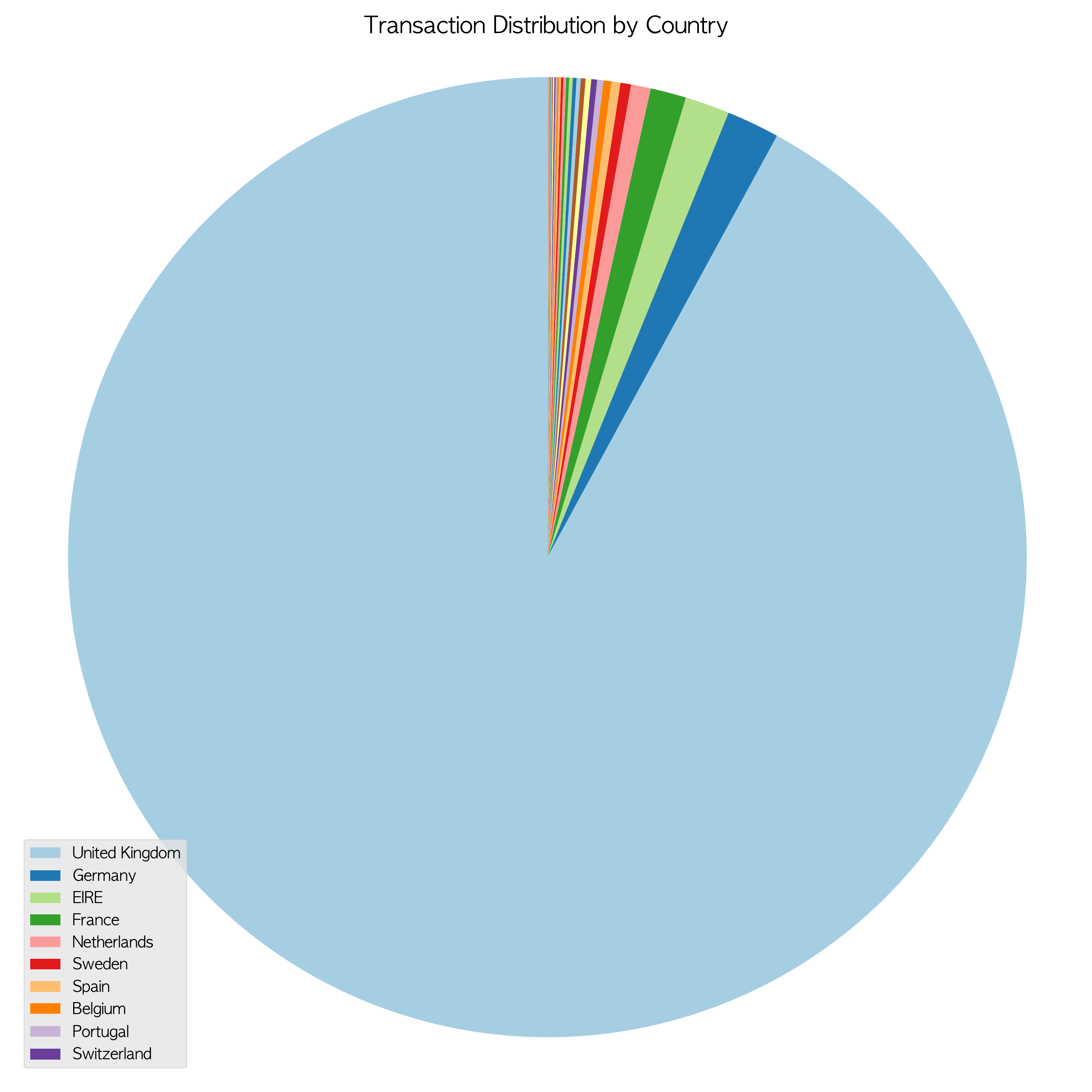
-
일년 중 가장 많은 거래와 revenue가 발생한 달은 9월부터 11월까지이다.
이때는 유독 christmas 관련 상품이 잘 팔리는 것으로 보인다. 이에 따라서 christmas를 겨냥한 holiday 프로모션을 진행하면 좋을 것 같다.
(heart와 bag 관련 상품도 이 시기에 판매율이 올라가지만 christmas만큼 가파르게 판매율이 오르지는 않는다.)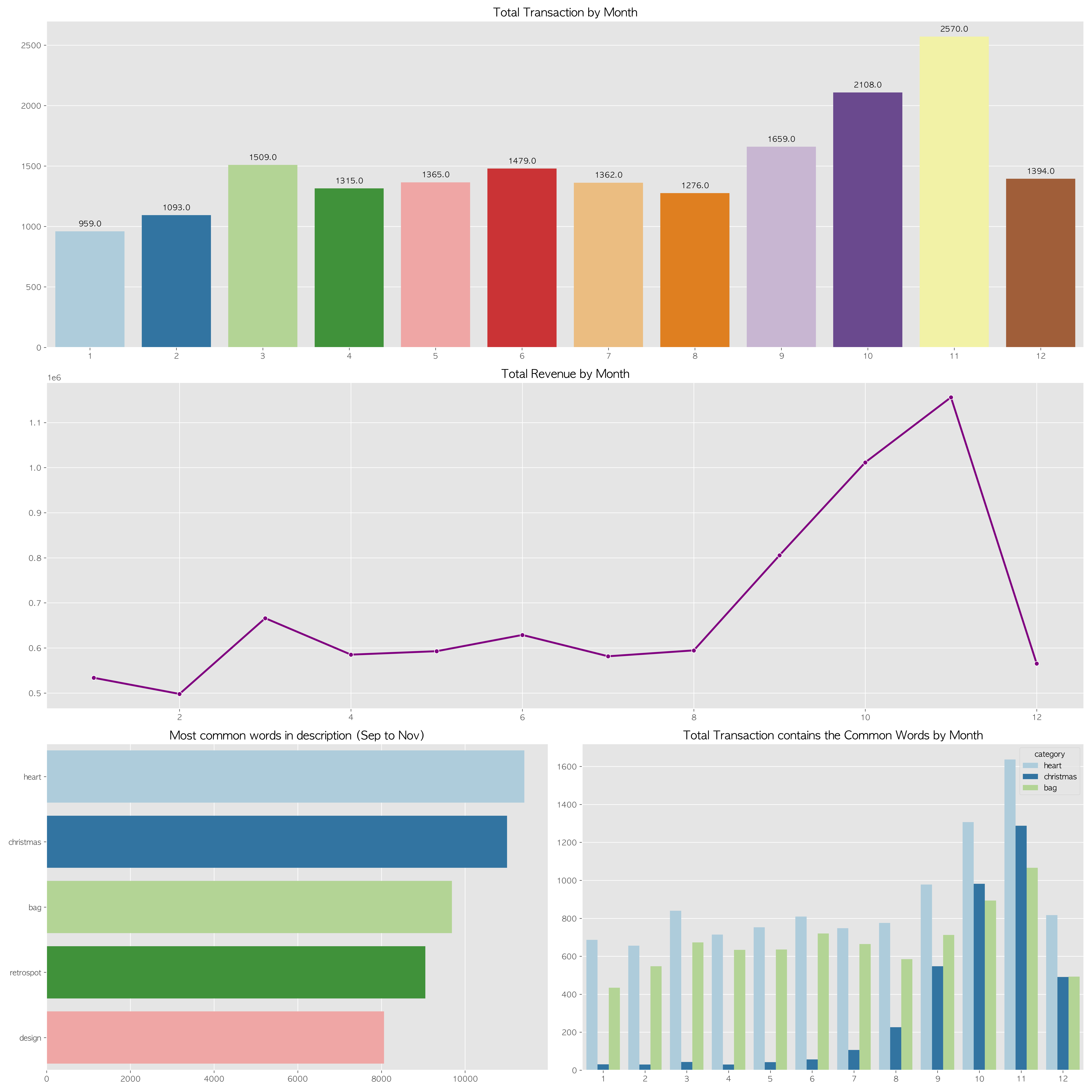
-
첫 구매가 상대적으로 적은 7월과 8월에 대대적으로 프로모션을 기획하여 구매를 일으켜서 고객으로 만들어야한다.
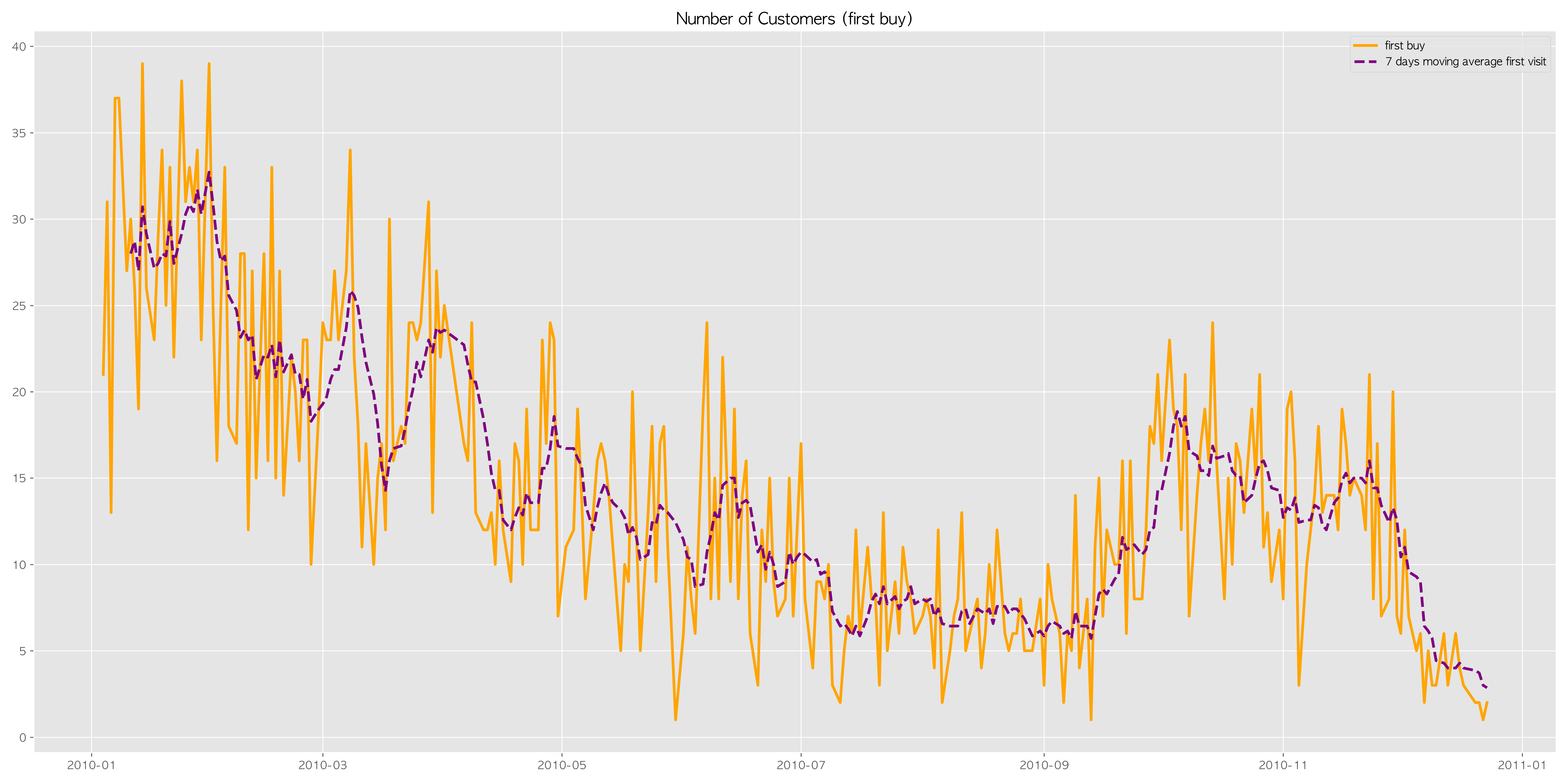
-
전체 고객층에서 at risk, potential loyal, loyal customers, can't loose them, new customers가 가장 많은 비율을 차지하고 있다.
그 중에서도 new customers가 가장 많은 revenue를 차지하고 있는 고객층이기 때문에 new customers를 안정적인 충성 고객으로 만들어야 한다.
그러기 위해서는 빠른 시일 내에 다시 구매를 하게 만들어서 전체 구매력을 올려야 한다.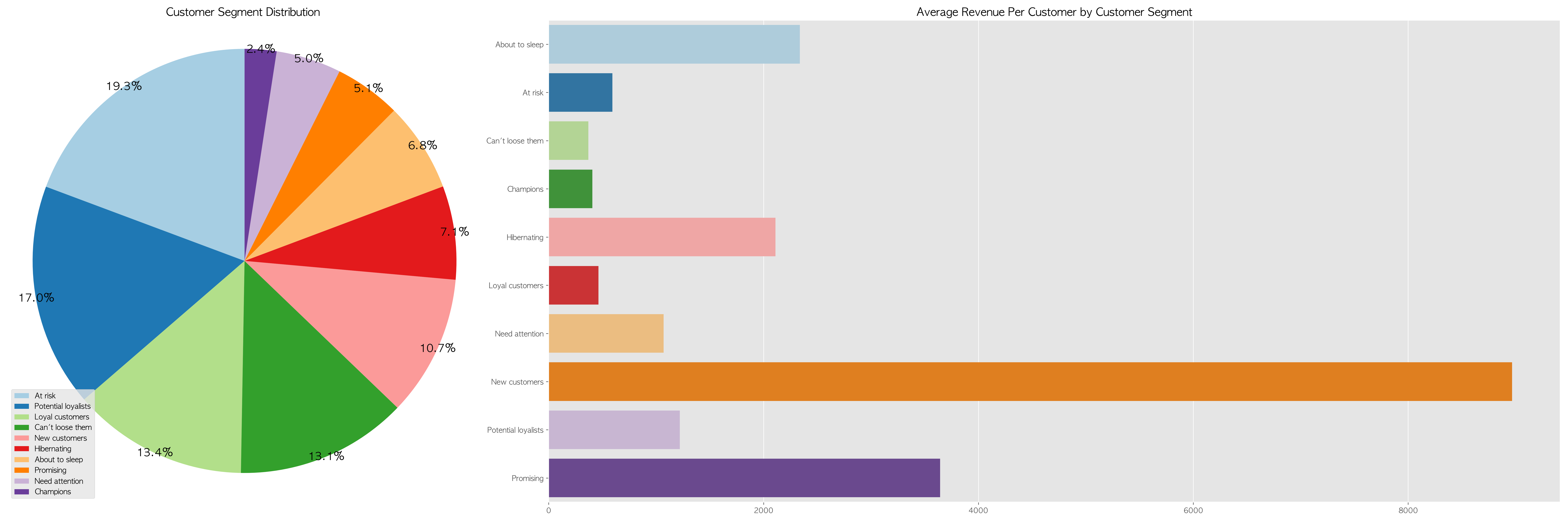
-
1월에 첫 구매를 한 고객들의 retention은 유독 좋은 편이기 때문에 다가오는 1월에 더 많은 고객들이 첫 구매를 할 수 있게 유도해야 한다.
